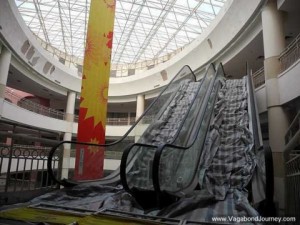We have spent a great deal of class time discussing China’s development and transition from an agriculture to industry. Just this passed week class articles have focused on migration and what specific aspects “pull” or “push” rural citizens to move to major cities. It is no secret that China is experiencing a mass-exodus of migrants from rural villages to industrial cities. Chinese leaders anticipated this movement early and since the 1980s has been erecting cities rapidly to hold the millions that migrate each year.
In many ways China was prudent and meticulous in handling the migration. Large apartment complexes were designed to hold workers and cities were designed around the industry sector they supported. However, party leaders may have jumped the gun when they built the New South China Mall. In terms of retail space for lease, the New South China Mall is the largest mall in the world. It was built in the city of Dongguan in the Guangdong province. Now the mall is 99% abandoned and is another one of China’s rushed and ill-conceived development projects that sticks out like a sore thumb.
The mall is in a 170 km urban area deemed a megalopolis. Hong Kong and Shenzhen are immediately to the southeast of the mall, while Macau is to the south, and Guangzhou is to the west. Authorities built the mall to help bring in a new age of consumerism in China. Unfortunately, like many of the other development projects in China, the mall is abandoned and highlights some of the over-zealous development projects China jumped into.
I have attached a video of the mall below.
Video: http://vimeo.com/55777507
Sources:
http://thechinachronicle.com/new-south-china-mall-the-worlds-largest-mall-is-still-99-deserted/
http://gizmodo.com/chinas-building-cities-so-fast-people-dont-have-time-1446570856

It sounds like the reason that 99% of the mall has been abandoned is due to inexperience in leasing and financing. Everyone started to believe China was turning into this new, consumer economy, but the developers of this project were overzealous and had too little experience to complete such a feat. They even tried to put a roller coaster inside of the mall. They seemed to be over reliant on the attracting factor of the mall that they did not put enough time and energy into the real business side of the development, and are left with a ghost mall.
Leasing and finance may have been issues, but the likely issue is ignoring the three laws of retailing: location, location and location. Are you located in a spot that people can get to? Are you located appropriately relative to other retailers – there’s a (positive) externality from being co-located with other retailers (including getting “anchor” stores in a mall). Is it located in an area that has lots of the target “yuppie” population? Likely “no” on all three counts.
I’ve seen this in real estate developments elsewhere (including early ones in Japan) that were opportunistic in the availability of land. Dongguan is an area of factories, not where high-end managers and entrepreneurs choose to base themselves, and certainly not where they shop. Likely the mall was located where the government could assemble a large plot of land, likely devoid of neighbors other than factories and low-end dorms. No nice restaurants, no consideration for parking, no subway to and from, only buses. Nearby Guangzhou and Hong Kong and Shenzhen all offer an (upscale) urban ambience that Dongguan lacks.
It seems like this is an example of how the Chinese prefer to build and then assume that the people will come on their own. Clearly they should have done more research into the location of the shopping mall and put it in a more upscale area of the country. Perhaps this will encourage China to rethink their consumer expectations.
It would be interesting to see if anyone actually lost money on this project or if the governments revenue was used and wasted to build this mall that no one goes to. If the national government could oversee all the project and discourage local governments from risky investments with taxpayer money. This article highlights the need for other forms of revenue creating opportunities for local governments.